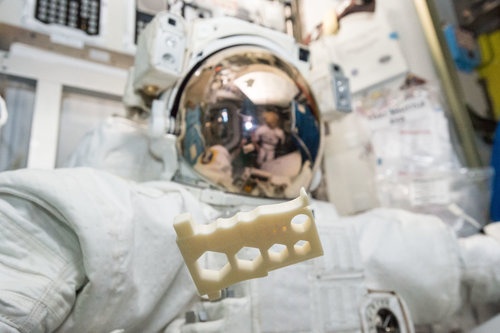ISS: 3D Printing in Zero Gravity
How 3D printing technology is adapted for use in space?
"Made In Space is working on expanding this technology to other realms of on-orbit manufacturing, including the construction of large-scale structures in free space by Archinaut." During an exclusive interview with 3YOURMIND Made in Space's Product Strategist, Harrison Pitman gave us insight into Zero Gravity production.
After a series of high-profile announcements in 2016, the space-based manufacturing company Made In Space has become the go-to point for additive manufacturing in the cosmos. Since 2013, the company has been developing the technology in cooperation with NASA. At the end of 2015, they were awarded an extended contract to lead the next phase of developing in-space manufacturing. Aerospace companies have been including 3D printing in their production cycle, but what is so innovative about Made in Space?

Photo source: Made In Space
What Has Been Made In Space’s primary activities?
Made In Space builds manufacturing facilities that are optimized for the microgravity environment of space. We built both 3D printers currently on the space station. In addition to 3D printing, we have several other space-based manufacturing initiatives, such as Made In Space Fiber, and Archinaut, a robotic manufacturing system that supports our vision of constructing large-scale space structures in orbit.
We focus on the ultimate goal of developing the technologies necessary for humanity to become a multi-planetary civilization. The projects below highlight both our existing products and some of our ongoing research efforts.
What is your current focus as it relates to 3D printing?
In 2016 we spent a significant amount of time developing our Additive Manufacturing Facility (AMF). This was launched in March 2016, and the AMF is a permanent manufacturing facility on the ISS. Unlike the earlier 3DP experimental printer, AMF prints with a wide range of polymers are designed to last the entire lifetime of the space station and are commercially available for customers on Earth who want to produce equipment for the ISS faster and much more affordable than traditional launch methods.

Photo Source: Made In Space
Material Recycler (R3DO)
R3DO (pronounced riːˈdu) is the codename for our zero-gravity material recycler. R3DO was designed so that material from waste products or previous prints could be melted down and turned back into 3D printing feedstock, considerably enhancing the sustainability and overall efficiency of off-world additive manufacturing. When we are thinking about long-term production for the various experiments that occur on the ISS by groups that are there from one week to one year, it is important that we can offer to print new equipment without constantly shipping new feedstock. We are working to develop a fully circular economy on the ISS!
Could you tell us a little bit more about the Archinaut project?
Archinaut is a robotic manufacturing system that supports our vision of constructing large-scale space structures in orbit. It extends the paradigm of additive manufacturing to include additive construction! The robotic hardware can be attached to an existing satellite, or roam as a ‘free flyer.’
Essentially the robot would be using standard AM practices, but would also have the capability to aggregate those prints and assemble them into large and complex systems in space without astronaut extravehicular activity. Because we don’t have concerns like gravity, it is suddenly possible to conceive of large-scale construction projects carried out by a relatively small robotic device, Archinaut.

Photo Source: NASA
We know that you are regularly printing objects with NASA, can you tell us how that communication occurs and what objects they are already using?
We often compare sending a command to our AMF to sending an email. We prepare a file including all 3D print commands and send it through NASA’s existing communication signals, just like many other on-orbit technologies are commanded.
NASA, along with several other organizations, including fortune 50 companies, such as Lowe’s Home Improvement, has already commissioned the printer to manufacture a number of tools, parts, and pieces for use on both the station and back on Earth. Made In Space is working on expanding this technology to other realms of on-orbit manufacturing, including the construction of large-scale structures in free space by Archinaut.
One of the important advantages that the AMF offers is the potential to rapidly manufacture solutions to problems that arise in orbit, as opposed to having to wait for parts to be up massed to the ISS-- a process that can take several months. I think it's important to think of the AMF as a tool in itself.
Made In Space also has a terrestrial printer (TAC3D), designed to suit additive manufacturing needs in the most extreme environments on Earth which experience many of the same logistic challenges!

What is your current mission?
To enable humanity's future of living and working in space, and to become a multi-planetary civilization. Until that happens, we've got our work cut out for us.
Harrison Pitman, Made in Space's Product Strategist.

Made in Space
Founded in 2010 with the goal of enabling humanity’s future in space, Made In Space, Inc. has developed additive manufacturing technology for use in the space environment. By manufacturing space assets in space, as opposed to launching them from Earth, the company plans to accelerate and broaden space development while also providing unprecedented access for people on Earth to use in-space capabilities.
